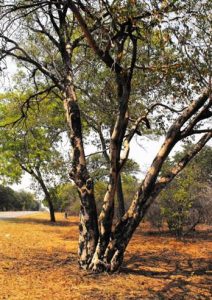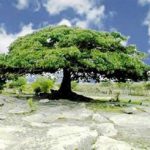TREE LIFE
August 2014
MASHONALAND CALENDAR
Sunday 17th August (3rd Sunday): Visit to Manda Hills, Concession. This is a new venue for the Tree Society. According to the publicity, it offers beautiful scenery, diverse species of trees, cave paintings, architectural artefacts, graves, fallen ancient walls, some trails, birds and 1000 hectares for hiking and camping.
For those interested in sharing vehicles, we will meet at CABS Head Office at Northridge Park in Borrowdale at 8 a.m., for a prompt start. Those who wish to travel directly are of course always welcome to do so. We will meet at Manda at 9.30 a.m. Please bring chairs, lunch and drinks as usual. There will be an entrance fee of $5 per person.
In case of need phone Kudzi on 0733-400-039.
Saturday 23rd August (4th Saturday): John and Dagmar Lawrence’s home,
It has been a long while since the Tree Society visited this garden and there should be plenty of interest. We will meet at 2.30 p.m. as usual.
ASTRONOMY CLUB We don’t normally include details of other Society’s events in Tree Life, but I have agreed to make an exception for this one – ED.
Something to do at night as long as the trees don’t get in the way!
Until some eight/nine years ago, we had an astronomy club in Harare which used to meet regularly once a month. It was known as the Astronomy Society of Southern Africa – Harare Centre, and thus answered to the parent body in South Africa. Recently, a meeting was held between some of the “old” members and a decision was made to resurrect the club. You are invited to attend the first evening meeting scheduled for Wednesday, 10th September to begin promptly at 6:00 p.m. The venue is: Lecture theatre, Saint Georges College. There will be a Power Point presentation on the constellations. You do not need a telescope to join in – with just a pair of binoculars you can see amazing stuff in the heavens!
– Tony Alegria
BOOKS FROM MARY LOVEMORE. Mary Lovemore has kindly presented to me a number of copies of past editions of the Zimbabwean botanical journal Kirkia.
I already have a set of these, so if anyone would like Mary’s books, please let me know. They are free to a good home.
– Mark Hyde
TREE OF THE MONTH
Guibourtia coleosperma
Family: Fabaceae – Caesalpinioideae
Botanical name: Guibourtia coleosperma
Common names: Eng: Large false mopane, Rhodesian copal wood, Umtshibi ; Nd: Umtshibi.
Etymology: Guibourtia: After Nicolas Jean B.G. Guibourt (1790–1867), Professor of Pharmacology in Paris; coleosperma means sheathed seed as opposed to gymnosporia meaning naked seed. (As a matter of interest a gymnasium should be more accurately called coleosium but now that we have thornless Acacias, Socrates must be turning in his grave).

Guibourtia coleosperma Large false Mopane
Guibourtia coleosperma is an evergreen tree ranging in height from 6 m to 20 m. They are easily spotted as their bark is spectacular. It is creamy white and smooth but most often with dark black patches as if they have been damaged by bushfires. The tree crown is generally well rounded with drooping branches; young branchlets being reddish.
As they mostly grow in Kalahari sand it is difficult to mistake them for anything else, the leaves superficially resemble those of the Colophospermum mopane but the silhouette of the two trees are very different, the mopane being more erect and the Umtshibi more rounded. The barks, as mentioned above, are totally different. Next time you go to Hwange, you can easily spot them on the side of the road to Main Camp mixed with Baikiaea plurijuga.

Leaves of Guibourtia coleosperma Large false Mopane
The leaves are compound with two ovate, curved, sickle-shaped and asymmetric leaflets; they are brighter green and more elongated than those of the mopane.
The flowers are small and whitish, 10 mm or so in diameter; they grow on long panicles from December to March.
The fruit is a small, thickly woody pod, almost circular, 2-3 cm long, brown to dark brown, splitting down one side, the valves curling back like lips to partially release the single seed.

Fruit of Guibourtia coleosperma Large false Mopane
The seed is up to 10 mm in diameter, shiny red with a scarlet aril, hanging out and down on a thread-like stalk. Fruiting is from May to July but may start earlier and last longer.
Surprisingly, I did not find any specific medicinal uses for Guibourtia, but the oily aril is used as food during times of famine and the pounded roasted seed is used to make a kind of porridge.
The most interesting and possibly the most unfortunate use of Umtshibi is in carving and woodwork. The enormous hippo carving, the large wooden dishes and many other artefacts one could buy at the Falls were made of Umtshibi. The beautiful pink wood makes splendid, very strong furniture and turned on a wood lathe, create delightful pieces. I even had a friend who used Umtshibi to build a yacht: all the stations were made of Umtshibi, strong, certainly, but what a waste. Worse: Once upon a time the wood was even used to make railway sleepers!!!
Sources: Trees of Southern Africa (Keith Coates Palgrave); Field guide to the Trees of Southern Africa (Braam and Piet van Wyk); The Indigenous Timbers of Zimbabwe (B. Goldsmith, D.T. Carter); A Rhodesian botanical dictionary (H. Wild), Ndebele Names of Plants in Zimbabwe (L.J. Mullin).
Photos JP Felu
– JP Felu
CAROLINA WILDERNESS AREA: 13 APRIL 2014
This is a rather belated write-up of this outing with apologies from your Chairman.
Carolina was a new location to me and consulting the maps in advance of the outing, I noticed that it lies just to the south of Lake Chivero, although of course we didn’t see the lake at all during our visit.
The habitat was also similar to Chivero and can best be described as sandveld or sandy miombo woodland. The altitude was 1400 m, just a little bit lower than Harare. The weather was perfect and we had a good turnout of members.
We parked amongst some lodges near to a dam. There were some planted trees, including some large specimens of Faidherbia albida, which were just coming into new leaf and flower. We were fortunate in having Tom Muller to lead us and Tom mentioned how this is a species of sandbanks and the pods are loved by elephants.
There was also a very large Acacia galpinii.
We wandered into the rather open woodland and came across a pure stand of young Terminalia sericea trees, behaving as a pioneer species. On the edge of nearby woodland was Burkea africana, Julbernardia globiflora and Piliostigma thonningii.
In the herbaceous flora was Rhynchosia monophylla, a small, almost prostrate legume. It’s flowers are bicoloured (yellow standard and red wings) and extremely pretty and the leaves are mostly simple.
A tree Pterocarpus caused a certain amount of debate because of the larger-than-expected number of leaflets but eventually we decided it must be P. rotundifolius subsp. rotundifolius. We also came across Pericopsis angolensis, usually a sign of a slightly lower altitude.
Some fine fruiting specimens of Vitex payos, the Chocolate berry, were seen. Two species in the coffee family were Vangueria randii and Psychotria kirkii.
We also came across the large fruits of Combretum zeyheri and the spiny stems of Pterolobium stellatum.
By noon, the Tree Society were beginning to suffer from what Tom called ‘staldrung’, the desire of a horse to return to its stable and so we headed back to the lodges for lunch.
In the afternoon, a small group of us did a short walk in the opposite direction in amongst some low rocky hills.
Here we came across the two best finds of the day.
The first was an unknown large-fruited climber. Although the fruits themselves looked rather like Cucurbits, the presence of milky latex and opposite leaves showed that the plant was an Apocynaceae. It was later identified by David Goyder, a specialist on the family at Kew, as Pentarrhinum insipidum. It’s quite a widespread species, but it’s certainly not something you often see in sandveld around Harare – or at least it was a first for me anyway.
The other plant of interest is a fleshy scrambling species called Solanecio angulatus. This is not so unusual, but is a somewhat local plant.
A final find of interest was the alien grass Harpachne schimperi which is continuing its slow spread around Harare. For those interested, there is a map of the known records of this species online at: https://zimbabweflora.co.zw/speciesdata/google-maps-display.php?species_id=105330.
The record furthest to the west is the Carolina one.
A map showing where we went on the day can also be seen online at: https://zimbabweflora.co.zw/speciesdata/utilities/utility-map-records-by-date.php?year_search=2014&month_search=04&day_search=13
To summarise, it was an enjoyable day in pleasant surroundings with interesting people. Nothing very startling on the tree front but one or two climbers and herbs were of interest.
– Mark Hyde



